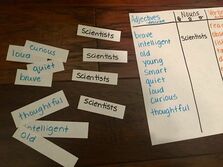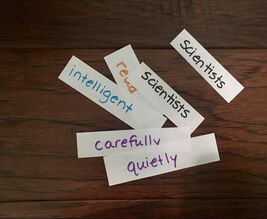Teaching language structures is one of the most important things we do with our English learners. Embedding academic vocabulary into the language structures is key to their academic success. Making it interactive, engaging, and fun bumps it up ten notches! The Sentence Patterning Chart (a GLAD strategy) that I wrote about last January is an excellent way to build content knowledge and help students acquire language structures through authentic shared writing. So if you haven't tried it yet, I highly suggest it. And if you have tried it, here's your next move!  Once you and your students have built the sentence patterning chart (SPC) together as a class and have made many sentences, you are ready for the Trading Game. This activity is best done on the subsequent day.  You will want to record all of the words that were brainstormed on the SPC on to smaller index cards or sentence strips that are cut. I like to color match my words. For example, I always write the adjectives in blue on the SPC, so when I record the adjectives on index cards, I write them in blue marker. This serves as a scaffold when students play the Trading Game.  Now divide the class into groups of about 4 students. And give each group a set of cards that includes 2 adjectives, the noun, a verb, an adverb, and a prepositional phrase. Be sure that each group has all the components that they need to create a complete sentence. Explicitly model for them how they will work together to 1. Read the words. 2. Decide how to arrange them into a complete sentence. And 3. Read the sentence aloud to the class.  After each group has created their sentence and read it aloud to the class, collect all the words and MIX them up! Give each group 6 RANDOM cards. This time they may get 2 nouns and no verbs. They will have to collaborate as a team to decide which parts of speech they are missing and which they have too many of. Explicitly model for them the language you wish for them to use. For example, "I want to hear you say, 'Do you have a noun I could trade for an adjective?' not 'I can give you a blue if you give me an orange.'" Then listen in as groups discuss. When all groups have created their sentences, allow time for sharing. The Trading Game is a fun, interactive and student centered method for weaving content and language together. Students are listening, speaking, reading, and writing as they craft sentences related to the unit of study.
5 Comments
1/19/2019 06:10:20 pm
I love how you have taken your chart and made it interactive. The activity embodies principles from Kagan and Beers! Keep on doing great work, Valentina!
Reply
valentina gonzalez
3/31/2019 11:39:45 am
Thank you, Tan! I'm delighted that you read this post!
Reply
Sarah
1/30/2019 12:11:22 pm
Your blog is so helpful. Thanks for sharing!
Reply
valentina gonzalez
3/31/2019 11:40:40 am
Hi Sarah,
Reply
4/5/2022 11:59:09 pm
Very much appreciated. Thank you for this excellent article. Keep posting!
Reply
Your comment will be posted after it is approved.
Leave a Reply. |
Categories
All
|


 RSS Feed
RSS Feed
